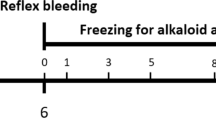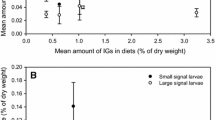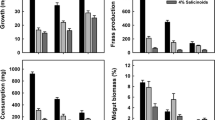Abstract
The lubber grasshopper,Romalea guttata, produces a metathoracic defensive secretion containing primarily phenolics and quinones. This insect feeds on a wide range of plant species. Insects reared on an artificial diet and a diet of onion,Allium canadense, had secretions that contained fewer compounds, lower concentrations of compounds, and markedly altered relative composition of components compared to insects reared on a varied diet of 26 plant species that included onion. The study demonstrates that diet breadth has a major effect on the quality and quantity of the autogenous defensive secretion of this generalist herbivore. The results are compared to diet effects known in chemically defended specialists. Two possible mechanisms explaining the effects of diet breadth are proposed: one involves changes in precursor availability with changing diet breadth; the other suggests that physiological stress due to diet restriction changes allocation of resources to chemical defense.
Similar content being viewed by others
References
Berger, R.S. 1976. 2,5-Dichlorophenol: Not synthesized by the Eastern lubber grasshopper.Ann. Entomol. Soc. Am. 69:1–2.
Blum, M.S. 1981. Chemical Defenses of Arthropods. Academic Press, New York, 502 pp.
Brower, L.P., Seiber, J.N., Nelson, C.J., Lynch, S.P., andTuskes, P.M. 1982. Plant-determined variation in the cardenolide content, thin-layer chromatography profiles and emetic potency of monarch butterflies,Danaus plexippus L., reared on the milkweed,Asclepias eriocarpa in California.J. Chem. Ecol. 8:579–634.
Brower, L.P., Seiber, J.N., Nelson, C.J., Lynch, S.P., andHolland, M.M. 1984. Plant-determined variation in the cardenolide content, thin-layer chromatography profiles and emetic potency of monarch butterflies,Danaus plexippus L. reared on milkweed plants in California. 2.Asclepias speciosa.J. Chem. Ecol. 10:601–640.
Conn, E.E. 1980. Cyanogenic glycosides.Encycl. Plant Physiol. 8:461–492.
Dadd, R.H. 1960. The nutritional requirements of locusts. I. Development of synthetic diets and lipid requirements.J. Insect Physiol. 4:319–347.
Daloze, D., andPasteels, J.M. 1979. Production of cardiac glycosides by chrysomelid beetles and larvae.J. Chem. Ecol. 5:63–77.
Duffey, S.S. 1976. Arthropod allomones: Chemical effronteries and antagonists.Proc. XV. Int. Congr. Entomol. 15:323–394.
Duffey, S.S. 1980. Sequestration of plant natural products by insects.Annu. Rev. Entomol. 25:447–477.
Eisner, T., Hendry, L.B., Peakall, D.B., andMeinwald, J. 1971. 2,5-Dichlorophenol (from ingested herbicide?) in defensive secretion of grasshopper.Science 172:277–278.
Fox, L.R., andMorrow, P.A. 1981. Specialization: Species property or local phenomenon?Science 211:887–893.
Jones, C.G., Hess, T.A., Whitman, D.W., Silk, P.J., andBlum, M.S. 1986a. Idiosyncratic variation in chemical defenses between individual generalist grasshoppersJ. Chem. Ecol. 12(3):749–761.
Jones, C.G., Hess, T.A., Whitman, D.W., Silk, P.J., andBlum, M.S. 1986. Idiosyncratic variation in chemical defenses between individual generalist grasshoppers.J. Chem. Ecol. 12(3):749–761.
Kevan, D.K.M. 1980.Romalea guttata (Houttyun), name change for well-known “Eastern Lubber Grasshopper” (Orthoptera: Romaleidae).Entomol. News 91:139–140.
Meinwald, J., Erickson, K., Hartshorn, M., Meinwald, Y.C., andEisner, T. 1968. Defensive mechanisms of arthropods. XXIII. An allenic sesquiterpenoid from the grasshopperRomalea microptera.Tetrahedron Lett. 25:2959–2962.
Nahrstedt, A., andDavis, R.H. 1983. Occurrence, variation and biosynthesis of the cyanogenic glucosides linamarin and lotaustralin in species of the Heliconiini (Insecta: Lepidoptera).Comp. Biochem. Physiol. 75B:65–73.
Pasteels, J.M., andDaloze, D. 1977. Cardiac glycosides in the defensive secretion of chrysomelid beetles: Evidence for their production by the insects.Science 197:70–72.
Pasteels, J.M., andGrégoire, J.-C. 1984. Selective predation on chemically defended chrysomelid larvae. A conditioning process.J. Chem. Ecol. 10:1693–1700.
Pasteels, J.M., Grégoire, J.-C., andRowell-Rahier, M. 1983a. The chemical ecology of defense in arthropods.Annu. Rev. Entomol. 28:263–289.
Pasteels, J.M., Rowell-Rahier, M., Braekman, J.C., andDupont, A. 1983b. Salicin from host plant as a precursor of salicylaldehyde in defensive secretion of chrysomeline larvae.Physiol. Entomol. 8:307–314.
Prestwich, G.D. 1983. Chemical systematics of termite exocrine secretions.Annu. Rev. Ecol. Syst. 14:287–311.
Wray, V., Davis, R.H., andNahrstedt, A. 1983. Biosynthesis of cyanogenic glycosides in butterflies and moths: Incorporation of valine and isoleucine into linamarin and lotausralin byZygaena andHeliconius species (Lepidoptera).Z. Naturforsch. 38c:583–588.
Author information
Authors and Affiliations
Rights and permissions
About this article
Cite this article
Jones, C.G., Hess, T.A., Whitman, D.W. et al. Effects of diet breadth on autogenous chemical defense of a generalist grasshopper. J Chem Ecol 13, 283–297 (1987). https://doi.org/10.1007/BF01025888
Received:
Accepted:
Issue Date:
DOI: https://doi.org/10.1007/BF01025888




